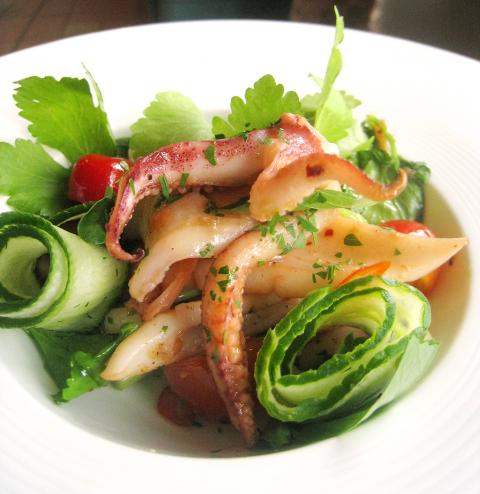Wonderful fresh Chinese celery (芹菜) has hit the market stalls with the warmer spring-like weather. It is plentiful, cheap and flavorful, and with a little tweaking, it can be the perfect substitute in many recipes for the big, chunky European celery imported from the US and elsewhere.
Another good reason to opt for Chinese celery over European is that according to this year’s Environmental Working Group report called the Shopper’s Guide to Pesticides (www.ewg.org/foodnews), conventionally grown celery in the US is among the top 12 fruits and vegetables on which pesticide residues have been most frequently found. It needs to be said that locally grown Chinese celery is not exempt. There have been reports of high levels of pesticide residue found in locally grown celery sold in supermarkets, but at least produce from small “organic” farmers is increasingly available.
Chinese celery is the same species as the European variety most people in the West are familiar with, but it has a number of important differences. The stems are much thinner, and the flavor is a little sharper. It is a close relation to smallage (also known as wild celery), which is used in some French cooking for its pronounced bitter flavor.

Photo: Ian Bartholomew
What Chinese celery lacks in bulk and physical heft, it more than makes up for in flavor. It is wonderfully refreshing and perfect as part of a light meal for the early spring.
The variety most commonly available in Taiwan is sometimes called Green Queen, also known as Shanghai celery, notable for its deep green stems and flavorsome leaves. The leaves can be eaten raw, but the stems can usually use a bit of cooking (even if just slightly wilted in the pan to reduce its pungency, as in the recipe provided). In Taiwan, it is a staple of various stir-fry recipes, providing a refreshing sharpness when fried with meat or hard tofu.
Chinese celery shares much the same health benefits as its European relatives, which means that there are far too many good things going on every time you take a bite of this mighty nutritional powerhouse for much detail to be given here. Suffice to say that it has powerful antioxidant and anti-inflammatory properties, is brilliant at keeping the digestive and urinary tract in good order and is beneficial to maintaining cardiovascular health.

Photo: Ian Bartholomew
All of this has not been sufficient to get people to actually like drinking celery juice, a vile concoction of nutritional gurus. The good news is that taking celery in this form is not necessary, and recipes like this one maintain its many benefits while still providing plenty of gustatory pleasure.
Pan-fried Squid and Celery Salad
Recipe (serves two)
Ingredients
2 medium squid
1 celery
2 cloves garlic, minced
1 small cucumber
2 tbsp rice vinegar
1 tbsp fine white sugar
1/4 cup white wine
1 tsp chili flakes (or to taste)
8 cherry tomatoes
Handful of basil leaves
2 stems flat leaf parsley, finely chopped
Olive oil
Directions
1. Clean the squid by pulling its head off and removing the innards. (Some people may find this a little icky, and most fishmongers will clean the cephalopods for you. This has many advantages, especially not having fishy, slimy kitchen waste to deal with, but they do not keep as well once cleaned.)
2. Remove the purplish membrane on the outside of the squid. This will generally come off easily with a little firm rubbing under the tap. Remove the beak and eyes but retain the tentacles.
3. Cut open the body and score the flesh with a sharp knife. Cut into lozenge shapes. Put together with tentacles and drain any excess liquid.
4. Mix the vinegar and sugar in a bowl. Add a pinch of salt. Use a peeler to cut long, thin slices from the cucumber. Soak the cucumber in the vinegar mixture until lightly picked, around 5 minutes. Pat dry with kitchen paper.
5. Wash the celery and separate leaves and stems. Remove any tough fibers from the outside of the stems, if any (these should hardly be present in the fresh, young celery plants you should be using for this dish). Wash and halve the tomatoes.
6. Heat a pan with olive oil until almost smoking then put the squid in. Add chili flakes. Season with salt and allow it to gain some color. Turn down the heat and add minced garlic. Add the white wine to deglaze the pan and check seasoning, adding more salt and pepper if necessary.
7. Throw in the celery. Over low heat, mix well, cooking for about 1 minute, coating the celery with pan juices. Remove from heat.
8. Add tomatoes and basil leaves to the pan. Mix and place into two bowls.
9. Decorate with the pickled cucumber, some tender celery leaves and a sprinkling of parsley.
Ian Bartholomew runs Ian’s Table, a small guesthouse in Hualien. He has lived in Taiwan for many years writing about the food scene and has decided that until you look at farming, you know nothing about the food you eat. He can be contacted at Hualien202@gmail.com.

Most heroes are remembered for the battles they fought. Taiwan’s Black Bat Squadron is remembered for flying into Chinese airspace 838 times between 1953 and 1967, and for the 148 men whose sacrifice bought the intelligence that kept Taiwan secure. Two-thirds of the squadron died carrying out missions most people wouldn’t learn about for another 40 years. The squadron lost 15 aircraft and 148 crew members over those 14 years, making it the deadliest unit in Taiwan’s military history by casualty rate. They flew at night, often at low altitudes, straight into some of the most heavily defended airspace in Asia.

Many people in Taiwan first learned about universal basic income (UBI) — the idea that the government should provide regular, no-strings-attached payments to each citizen — in 2019. While seeking the Democratic nomination for the 2020 US presidential election, Andrew Yang, a politician of Taiwanese descent, said that, if elected, he’d institute a UBI of US$1,000 per month to “get the economic boot off of people’s throats, allowing them to lift their heads up, breathe, and get excited for the future.” His campaign petered out, but the concept of UBI hasn’t gone away. Throughout the industrialized world, there are fears that

Taiwan’s democracy is at risk. Be very alarmed. This is not a drill. The current constitutional crisis progressed slowly, then suddenly. Political tensions, partisan hostility and emotions are all running high right when cool heads and calm negotiation are most needed. Oxford defines brinkmanship as: “The art or practice of pursuing a dangerous policy to the limits of safety before stopping, especially in politics.” It says the term comes from a quote from a 1956 Cold War interview with then-American Secretary of State John Foster Dulles, when he said: ‘The ability to get to the verge without getting into the war is

Like much in the world today, theater has experienced major disruptions over the six years since COVID-19. The pandemic, the war in Ukraine and social media have created a new normal of geopolitical and information uncertainty, and the performing arts are not immune to these effects. “Ten years ago people wanted to come to the theater to engage with important issues, but now the Internet allows them to engage with those issues powerfully and immediately,” said Faith Tan, programming director of the Esplanade in Singapore, speaking last week in Japan. “One reaction to unpredictability has been a renewed emphasis on